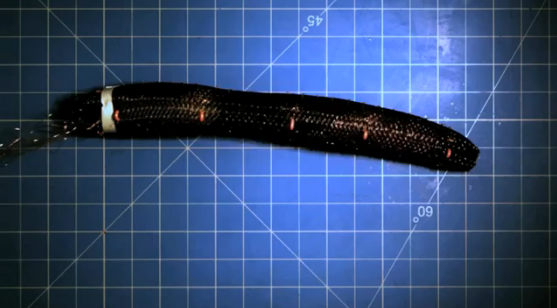New Robot Crawls Like an Earthworm

Dubbed the "Meshworm," a new bio-inspired robot stretches and contracts to crawl across the ground like an earthworm. But unlike its living, breathing counterpart, this artificial creature is durable enough to survive being bludgeoned by a hammer.
"You can throw it, and it won't collapse. Most mechanical parts are rigid and fragile at small scale, but the parts in Meshworms are all fibrous and flexible," said mechanical engineering researcher Sangbae Kim in a statement from MIT. "The muscles are soft, and the body is soft … we're starting to show some body-morphing capability."
Earthworms have two muscle groups in their bodies that work together to help it move on the ground. Circular muscle fibers that wrap around the worm's tubular body move it forward and muscle fibers that run along the worm's length move it right and left.
The researchers tried to imitate this structure for their robot. They made a long tube-like body with a sheet of flexible polymer mesh and created artificial muscles with a nickel-titanium alloy. Like the earthworm's muscles, some of these metal wires were coiled around the robot while others spanned its body from front to back, the statement from MIT said. [See Earthworm-Robot Video]
A small battery and circuit board was added to the tube to produce a current to heat the wires at certain segments along the body. Heat causes the "muscles" to contract and the researchers developed algorithms to control the wires' heating and cooling, directing different patterns of movement.
Though small, the Meshworm is durable. The robot squirmed away unscathed after being stepped on, thrown and hit with a hammer, the researchers said. They believe soft robots like the Meshworm might be able to explore tight spaces and travel easily over bumpy terrain. The model could even have applications in electronics, endoscopes, implants and prosthetics.
"Even though the robot’s body is much simpler than a real worm — it has only a few segments — it appears to have quite impressive performance," Kellar Autumn, of Lewis and Clark College, said in the statement from MIT. "I predict that in the next decade we will see shape-changing artificial muscles in many products, such as mobile phones, portable computers and automobiles."
Sign up for the Live Science daily newsletter now
Get the world’s most fascinating discoveries delivered straight to your inbox.
Details of the design were published in the journal Transactions on Mechatronics.











